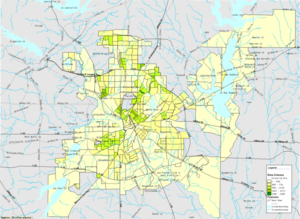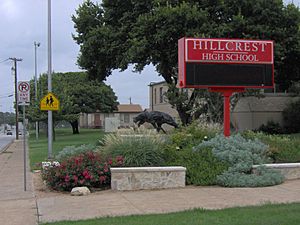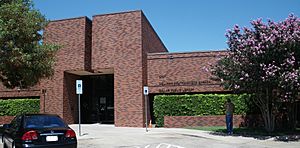Vickery Meadow, Dallas facts for kids

Vickery is a lively neighborhood in Northeast Dallas, Texas, United States. It's known for its many apartment buildings and a mix of people from all over the world. The neighborhood is generally located between Northwest Highway, Royal Lane, Central Expressway, and Abrams. It is one of the most crowded areas in Dallas and is home to many families who have moved there from other countries.
Vickery was first built in the mid-1970s for adults without children. By the early 1980s, most of the area was developed. After the Fair Housing Act was passed in 1968, more families with children began to move in. This led to a big change in the types of people living there, with many immigrants and refugees making Vickery their home. Because of this, the local schools became very full. The school district built new schools, including a high school, a middle school, and several elementary schools, to help. Some old apartment buildings were even taken down to make space for these new schools.
In 2014, a health concern in the area affected some residents. This event brought a lot of attention to Vickery.
Contents
A Look at Vickery's Past
Vickery is located in north central Dallas County, near major roads and railway lines. The area was first settled in the 1850s by John J. and William Jenkins. A small community slowly grew around their homes. In 1873, a railway line was built through the area.
In the early 1900s, before World War I, a man named John E. Vickery planned and promoted a new townsite. It even got its own post office in 1912. Ten years later, in 1922, the community had about 200 residents. It had several stores, car repair shops, churches, a bank, and a public school. The number of people living in Vickery changed over the years, from 800 in 1927 to 200 in 1933. By 1941, about 1,000 people lived there. Dallas officially took over the community in March 1945.
The area grew with many apartment buildings starting in the 1970s. These apartments were built for the many people moving to Dallas at that time. When it was fully built, Vickery had about 15,500 apartments and 2,300 condos.
At first, many of these residents were young and planned to live in Vickery for a short time. They then hoped to buy houses in the Dallas suburbs.
In 1988, the U.S. government passed the Fair Housing Act. This law made it illegal to stop families with children from living in apartment complexes. This law, along with lower rent prices, caused the neighborhood to change a lot in the 1990s. Many immigrants and refugees from places like Mexico, Central America, Bosnia, Burma, Bhutan, and Africa moved into the apartments. The area was not originally built for so many families.
To help improve the neighborhood, a group called the Midtown Improvement District (MID) started in 1993. This group works to make life better for residents and to help property owners.
Who Lives in Vickery?
Vickery is the most crowded community in Dallas. Many of its residents are immigrants and refugees. People from other countries often choose Vickery because it has affordable housing, access to healthcare, and good public transportation.
The main part of Vickery, called the Midtown Improvement District, covers about 2.86 square miles. In 2004, about 40,646 people lived there. Many of these residents were children and young people. About 39% of the people in Vickery were considered to be living in poverty. Most residents stay in Vickery for less than five years.
The population is very diverse. About 40% of the people are Hispanic or Latino, 32% are White, 22% are African-American, and 6% are from other groups, including many from sub-Saharan Africa.
In 2004, Vickery had nearly 15,000 homes. Most of these were apartment units, with some condominium units and a few single-family houses. There were 102 apartment buildings, ranging from small ones with six homes to very large ones with over a thousand homes.
Learning in Vickery
The Dallas Independent School District (DISD) runs the public schools in Vickery. Five DISD schools are located within the Midtown Improvement District.
Local Schools
Several elementary schools serve the Vickery area. These include Jack Lowe, Sr. Elementary School, Lee A. McShan, Jr. Elementary School, and Jill Stone Elementary School at Vickery Meadow. Other elementary schools that serve parts of Vickery are L. L. Hotchkiss Elementary School and Dan D. Rogers Elementary School.
For middle school, most students go to Sam Tasby Middle School. For high school, most attend Emmett J. Conrad High School. Both of these schools are within the improvement district. A smaller part of Vickery is zoned to Benjamin Franklin Middle School and Hillcrest High School.
Jill Stone Elementary School has two main buildings and several portable classrooms. One building holds offices and classrooms, while the other has common areas. Lee McShan Elementary School is a large school with many classrooms, an auditorium, and a gym. Lowe Elementary also has many classrooms. Tasby Middle School and Lowe Elementary share a campus and some common areas, but they have separate entrances.
How Schools Changed Over Time
In the 1990s, the number of children in Vickery grew a lot. This meant more students in public schools, so new schools had to be built. The Vickery Meadow Improvement District worked with Dallas ISD to create these new campuses.
In 1994, Hotchkiss Elementary School reopened as a neighborhood school. It quickly became very full, needing many portable classrooms. Most of its students came from the apartments in the area.
In 1998, Vickery Meadow Elementary School opened. It was the first school built right in Vickery Meadow. This school was later renamed Jill Stone Elementary School at Vickery Meadow in 2005. When it opened, 400 students who used to be bused to other schools could now walk to their local school.
In the 2000s, four apartment complexes were torn down to make space for four new schools. In 2005, Lee McShan Elementary School opened. In 2006, Lowe Elementary, Tasby Middle School, and Conrad High School also opened. Before these schools were built, most Vickery Meadow students went to Benjamin Franklin Middle School and Hillcrest High School. The land where Tasby and Lowe schools now stand used to be an apartment complex.
Community Colleges
Dallas College operates community colleges in the area. The closest campus to Vickery is Richland College in Dallas.
Public Libraries
Vickery Park Library The Vickery Park Branch public library opened in 2021. It is located at 8383 Park Lane. This library is a community hub for learning, culture, and special events for young people and families.
Skillman Southwestern Library
The Skillman Southwestern Branch Library of the Dallas Public Library is located south of Vickery. It opened in July 1996. This library was built thanks to a plan approved by Dallas voters in 1978. When it opened, library officials said it met the needs of a community that had not had an easily reachable library for a long time.
Groups That Help the Community
Many non-profit organizations work in Vickery to help residents.
In 1997, the Preston Hollow Presbyterian Church started Literacy Achieves (formerly Vickery Meadow Learning Center). This group offers free English-language classes for adults and young children. They also offer classes to help people become citizens.
Love Is Vickery Ministry began in 2009. It is a Christian group that runs programs in several apartment buildings in Vickery. These programs include a computer lab for learning skills, ESL classes, after-school tutoring, and help for new families. They also have a youth summer soccer league. All these programs are free and run by volunteers and donations.
Heart House Dallas was founded in 2000. It is a non-profit organization that runs a free after-school program. This program gives children a safe place to go and helps them with their schoolwork. It also encourages them to be good citizens. Heart House Dallas mainly works in the Vickery neighborhood, helping children in kindergarten through eighth grade from different apartment communities.
Businesses in Vickery
The main store for Half Price Books is located in Vickery. It is in a large warehouse and has a small coffee shop called Black Forrest Coffee. It also has comfortable sitting areas. Many events happen here throughout the year, like group meetups, live music, game nights, and author talks. It is also a pet-friendly place.
Other big businesses in Vickery include REI and Costco. The Costco Business Center in Vickery is the only one of its kind in Texas.



